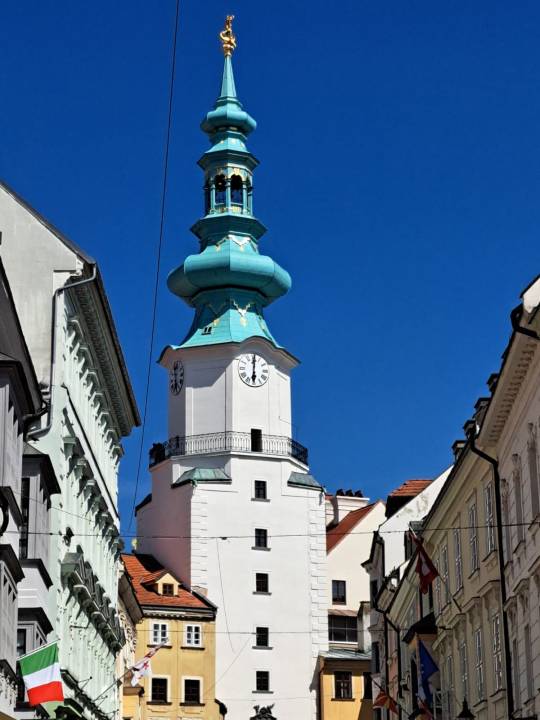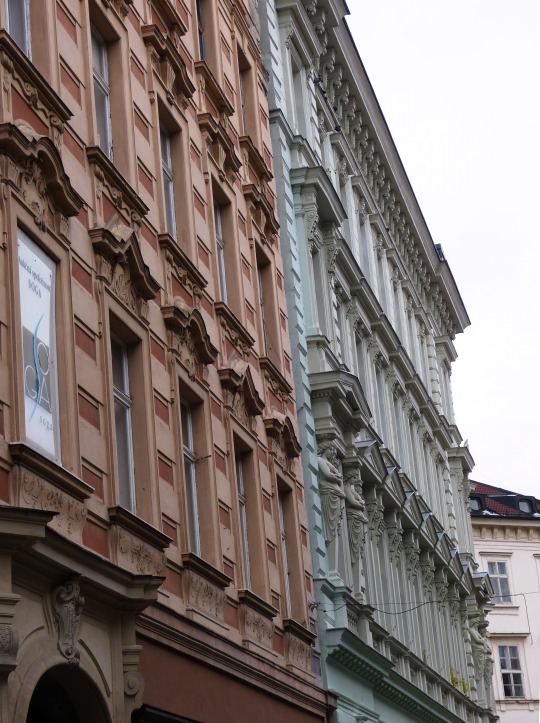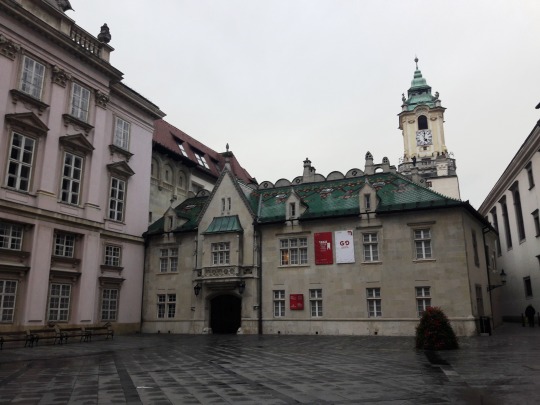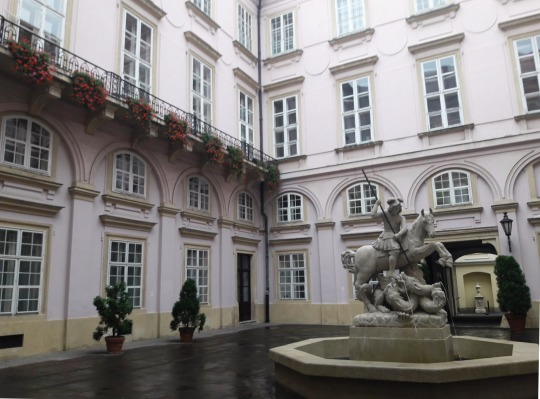#Prešporok
Explore tagged Tumblr posts
Text

Michael's Gate is the only city gate of Bratislava that has been preserved of the medieval fortifications. Michalská brána je jediná zachovaná brána z pôvodných štyroch v bratislavskom mestskom opevnení, dnes pamiatka v Starom meste. Das Michaelertor (auch der Michaelertorturm) ist das einzige erhalten gebliebene Tor der mittelalterlichen Stadtbefestigung von Pressburg. Михайловские ворота — единственные ворота, сохранившиеся со Средневековья в Братиславе.
#Michalská brána#Michael's Gate#Mihálykapu#Michaelertor#Михайловские ворота#Michaelertorturm#Staré Mesto#Old Town#Altstadt#Старый город#Bratislava#Prešporok#Pressburg#Pozsony#Istropolis#Bratysława#Братислава#Прешпорок#Пресбург#Пожонь#Истрополис#Slovensko#Slovakia#Slowakei#Slovaquie#Словакия#Słowacja
3 notes
·
View notes
Text
Bratislava, or Prešporok (Pressburg, Poszony)? Which One Is The Real Name of Slovakia's Capital City?
Good morning everyone,
Let me begin my blog, "Around Slovakia with Jakub Sevcik," with the Slovakia's Capital City. Did you know that all these names mentioned above have been used for Slovakia's capital throughout history? Today, we call this city Bratislava. It’s Slovakia’s administrative, cultural, and economic center, located in the southwestern part of the country along the Danube River.

(Panorama of Bratislava taken by me)
We will begin the day at the Bratislava Castle and its surrounding gardens. Bratislava Castle once served as the residence of important figures in the Austro-Hungarian Empire. Currently the castle serves as a representative venue for the Slovak Parliament and houses collections of the Slovak National Museum. In front of the castle, you’ll find a large Statue of Svätopluk, a key historical figure in the region that is now Slovakia. Bratislava Castle also provides beautiful views on the Danube River and the whole city of Bratislava.

(Photo of Bratislava Castle taken by me)
From Bratislava Castle we will move on to Slavín Monument. Slavín is a memorial and cemetery in Bratislava, honoring soldiers who died liberating the city in April 1945 during World War II. It’s a peaceful site worth visiting to honor those who fought for our freedom.

(Photo of Slavín Monument taken by me)
After visiting this memorial we will go to the Old Town of Bratislava. This historic part of the city features monuments such as St. Martin’s Cathedral, where the famous Queen Maria Theresa was crowned; Grassalkovich Palace, the residence of Slovakia’s President; the Blue Church; Michael’s Gate; the historic Slovak National Theatre building; and the well-known Slovak Radio Building, shaped like an upside-down pyramid, along with many other Baroque-style buildings.

(Photo of Grassalkovich Palace taken by me)
To finish our first day we will visit a little bit more modern and more luxurious part of Bratislava which is located by the banks of the Danube River. First, we’ll take a walk along the banks of the Danube River, where you can see the Statue of M. R. Štefánik, one of the most important figures in Slovak history, and admire the modern architecture while watching a beautiful sunset over the river. We’ll end the day at the UFO restaurant, located on a top of the SNP Bridge (Slovak National Uprising Bridge), where we can enjoy fine dining while taking a look at breathtaking night views of Bratislava.

(Photo of Sunset over Danube River & Slovak National Uprising Bridge with UFO Restaurant taken by me)
Have you ever been to Bratislava? What was/would be your favorite to-go spot in Bratislava? Let me know in the comments!
That wraps up our first adventure in Bratislava! Whether you're into history, stunning architecture, or modern city vibes, this city has it all.
Tomorrow, we will dive into the region of Slovakia where I grew up! Stay tuned!
Best,
Jakub The Traveler
Great YouTube videos about Bratislava:
Bratislava from Drone: https://youtu.be/LhZr86v8vRM?si=GH7eM0y9v2MmZvUo
Top 17 Things To Do in Bratislava: https://youtu.be/VWVR3AZhrdI?si=eXfmVSWHmo-SF-dy
Articles & Information to the places we were visiting today:
History of Bratislava: https://www.visitbratislava.com/about/culture-and-history/
Bratislava Castle: https://www.visitbratislava.com/places/bratislava-castle/
Slavin monument: https://slovakia.travel/en/slavin-bratislava
Old Town monuments:
St. Martin’s Cathedral: https://www.visitbratislava.com/places/st-martins-cathedral/
Grassalkovich Palace: https://www.visitbratislava.com/places/grassalkovich-palace/
Blue Church: https://www.visitbratislava.com/places/blue-church/
Michael’s Gate: https://www.slovakia.com/sightseeings-museums/michaels-gate/
Old Building of Slovak National Theatre: https://www.visitbratislava.com/places/opera-slovak-national-theatre/
Slovak Radio Building “Upside Down Pyramid”: https://www.visitbratislava.com/places/slovak-radio/
Modern Part of the City by Danube: https://www.visitbratislava.com/about/modern-city-on-the-danube/
UFO Restaurant: https://www.visitbratislava.com/places/ufo/
1 note
·
View note
Text
Pán Štúr, nerada Vám to hovorím takto na rovinu, ale meno Prešporok sa dneska už nepoužíva. Prešporok je dnes Bratislava!
Peši to ide síce pomalšie do Prešporku, ale za to sa môžem kochať našou krásnou prírodou i keď je zima. Našťastie ako duch rozdiely v teplote nepociťujem, môžete mi závidieť...
Avšak jedna vec, ktorá ma zaskočila, boli akési desivé štvorkolesové obludy, v ktorých sedeli práve ľudia! Až ma takmer vykotilo, tá plechová ohyzda vrčala asi tak ako Bernolák v pravoslávnom kostole.
Počas dňa na ulici som uvidel jednu matku s malým chlapčekom, zdravým slovenským obrodencom na ceste k svojej sláve, a jeho matka mu vravela, že si musí na autá dávať pozor. Autá teda, áno?
Skutočne zaujímavé, hoci z časti desivé. To už naozaj prešlo toľko rokov od mojej smrti? Ale je krásne počuť ten náš ľubozvučný jazyk v bežnej komunikácii bez toho, aby sa ľudia museli báť prenasledovania alebo potrestania.
Snažím sa sledovať aj tabule pri cestách (Aj tie sa zmenili a neprášia tak, ako kedysi!), ale nie a nie Prešporku ani na jednej z nich.
Drahí moji Slováci, čo sa stalo s Prešporkom? Vari ho Uhorsko skántrilo? Len to prosím nie!
60 notes
·
View notes
Photo

🇭🇺 1848/48 - márciusi megemlékezés Pozsony fontos szerepet játszott az 1848/49-es szabadságharc előzményeiben, történéseiben és az azt követő eseményekben. Számtalan szállal, helyszíneken, személyeken, történéseken keresztül kötődnek az egykori koronázási városhoz. Az alábbi rövid ismertető programunkban többet is megtudhatnak a Pozsonyhoz kapcsolódó történelmi személyekről, eseményekről és helyszínekről. Személyesen ugyan nem tudjuk meglátogatni azokat, virtuálisan azonban bebarangolható a város. Sétáljanak egy jót a múltban és Pozsonyban! 👉 https://wordart.com/ha2pa7dxzgs6/1848%2F49 A szövegek és képek forrása: A Szlovákiai Magyar Kultúra Múzeuma Itt az idő! 1848/49 Pozsonyban c. 2019-es kiállítási katalógusa 🇸🇰 Spomienka na marec 1848/49 Bratislava zohrala dôležitú úlohu pri udalostiach revolúcie za nezávislosť v rokoch 1848/49. Bývalé korunovačné mesto sa k udalostiam viaže cez rôzne miesta a osobnosti. V našom krátkom programe sa o nich dozviete viac. Aj keď sa jednotlivé miesta nedajú navštíviť osobne, virtuálne je možné túlať sa po meste. Dajte si prechádzku do minulosti v Prešporku! 👉 https://wordart.com/4woo7mvnmwhh/1848%2F49-sk Zdroj textov a obrázkov: Katalóg výstavy Nastal čas! 1848/49 v Prešporku Múzea kultúry Maďarov na Slovensku z roku 2019 #1848/49 #Pozsony #Prešporok https://www.instagram.com/p/CMbnpS7L5TW/?igshid=189n8qbflwhdn
0 notes
Note
heyhey, i noticed you commenting “that checks” and expressing surprise that the flags are correct on the montero post— im op of those two blogs, and im ukrainian and polish american :0 (first gen)!! a good amnt of research (and understanding from my own cultures) goes into those blogs. glad you appreciated it! also, i really appreciate the affirmation! a lot of people deny the jewish history in central europe, and years ago id been vagued and msged on anon to stop making jewish central slavs…. which was strange to me, as although i understand the history of the last century (and the pogroms beforehand of course), as a jewish eastern and central euro slav myself that was always what was most authentic for me to create.
so i just wanted to thank you for seeing a post set in a shtetl and not freaking out, basically.
have a swell rest of your day!
- adéla and jaro mun :D
Im glad I made your day. Something in me (because Im ill rn) thought to search aph Slovakia on Tumblr and here we are.
Im Hungarian Slovak, so my relationship with Slovakia is... complicated. I was born and raised here and thankfully, there are not so big differences between Hungarians and Slovaks nowadays.
I´ve just recently found out that surprisingly large amount of culture and history is between Jews and Central/Eastern Slavs. If there´s anything you guys deserve, it´s recognition. Our profesor told us that before the WWII, every person from Prešporok/Pressburg/Pozsony (nowadays Bratislava) knew Jewish songs, holidays and cuisines. Now my dad doesn´t even know what Hanukkah is. The knowledge is recovering, but slowly, some many people are ignorant about other religions and cultures. Even after 30 years, we still learn the Soviet version of history, which is a shame.
It was great hearing from you, hope your ancestry won´t be forgotten! So many places in America were touched by Slavs and many don´t seem to realise that.
Happy holidays
2 notes
·
View notes
Photo

Kingdom of Hungary, Ethnic map, 1910.
Ethnicities
Orange = Hungarians
Yellow = Germans
Black Spots = Romani (Literally Gypsy)
Pink/Purple = South Slavs
Light pink = Serbs
Dark pink = Croats
Pinky purple = Slovenes
Purple = Bulgarians
Green/Brown = North Slavs
Dark green = Slovaks
light green = Czechs
Browny green = Poles
Brown = Ukrainians/ Ruthenians
Blue = Romance Peoples
Light blue = Romanians
Dark blue = Italians
Religions
Római Katolikus = Roman Catholic
Ortodox = Orthodox
Református = Calvinisim
Görög Kat = Greek Catholic
Evangélikus = Lutheran
Izraelita = Jewish
Unitarius = Unitarian
Cities
Hungarian = Current Country = German
Sorpon = Ödenburg (Still in Hungary)
Kassa = Košice(SK) = Kaschau
Pozsony = Prešporok(SK) (now Bratislava) = Preßburg (now Bratislava)
Budapest = Ofenpest or Ofen-pest(both rare archaic) (Still in Hungary)
Ungvár = Uzhhorod(UA) = Ungwar or rarely Ungstadt or Ungarisch burg (Uschhorod is the transliteration)
Munkács = Mukachevo(UA) = Munkatsch
Szatmárnémeti = Satu Mare(RO) = Sathmar
Kolozsvár = Cluj(RO)(now Cluj-Napoca) = Klausenburg
Marosvásárhely = Târgu Mureș(RO) = Neumarkt am Mieresch
Brassò = Brașov(RO) = Kronstadt
Nagyvárad = Oradea(RO) = Großwardein sometimes just Wardein
Arad (in Romania but this is the only name for the city)
Temesvár = Timișoara(RO) = Temeswar also Temeschburg or Temeschwar
Nagyszeben = Sibiu(RO) = Hermannstadt
Fiume = Rijeka(HR) = Sankt Veit/Veith am Flaum/Pflaum
Zágráb = Zagreb(HR) = Agram
Szabadka = Subotica(RS) = Maria-Theresiopel or just Theresiopel
Pécs = Fünfkirchen (Still in Hungary)
Eszék = Osijek(HR) = Esseg or Essegg or Essek
Újvidék = Novi Sad(RS) = Neusatz
134 notes
·
View notes
Photo

Lenka ve svém krásném rodném městě (Prešporok, Pressburg, Poszony, Istropolis a nikdy Blava, jako San Franciscu nikdy neříkejte Frisco) (at SOHO Laurinská) https://www.instagram.com/p/B9cqomwHAzVaNQrhY0jQWLmXi9OOR1Wc2YbRh40/?igshid=phgr0fajxirh
0 notes
Text
L’architecture de l’ancienne enceinte fortifiée de Bratislava

Emplacement de la douve moyenâgeuse et Tour de la Porte Saint-Michel
Bratislava* est la capitale de la Slovaquie (Slovakia).
Au Moyen-âge, elle était fortifiée. La partie piétonne de la vieille ville, Staré Mesto, correspond à peu près à la cité médiévale.
*Jusqu’en 1919, son nom était Prešporok en slovaque, Prešpurk en tchèque, Pressburg en allemand, Pozsony en hongrois et Presbourg en français.
Photos Nathalie (2,4,6-8) et Bertrand (1,3,5,9-14) Donadille, octobre 2018
Des quatre portes de cette enceinte, il ne reste plus que la Porte Saint-Michel (Michalská brána) construite vers 1300.
L'aspect actuel de la Tour Saint-Michel date du XVIIIe siècle. A son sommet se dresse la statue de l’archange.


A côté de la tour, se trouve le Musée de la pharmacie (Múzeum farmácie ou Farmaceutické Múzeum), situé dans l’immeuble baroque de l’ancienne Pharmacie aux Ecrevisses Rouges dont l’origine remonte au XVIe siècle.

Michalská ulica (”ulica” veut dire “rue”) est la première artère que l’on emprunte lorsqu’on entre dans la vieille ville par la Porte Saint-Michel.


Les façades colorées des édifices apportent une touche de gaieté, même sous le ciel gris.
On en voit partout, comme dans Panská ulica...


... ou Laurinská ulica.

Hlavné námestie, littéralement la “principale place”, est considérée comme le coeur historique de la capitale.

L’ancien hôtel de ville, Stará Radnica, dont les bâtiments datent essentiellement des XIVe et XVe siècles. abrite maintenant le Musée d’histoire de la ville de Bratislava, Múzeum mesta Bratislavy.
Il donne, à la fois, sur Hlavné námestie et sur Primaciálne námestie, de l’autre côté.

A gauche de Stará Radnica, reconnaissable à sa tour construite au XIIIe siècle et à sa toiture aux tuiles colorées. il y a le Palais primatial, Primaciálny palác, de style classique, achevé en 1781.
Ancienne résidence de l’archevêque, c’est l’hôtel de ville depuis 1903.
A l’intérieur, dans la cour du palais primitif, on peut voir la Fontaine de Saint-Juraj, Fontána Svätý Juraja, un chevalier légendaire combattant un dragon.

Parmi les nombreux édifices religieux de la cité slovaque, l’Eglise Clarissine, Kostol klarisiek, encore appelée, Eglise de l’Elévation de la Sainte Croix, Kostol Povýšenia Svätého Kríža, fait partie d’un ensemble monastique du Moyen-âge, l’ancien couvent des Clarisses, construit à partir de 1297.
Après la dissolution de l’ordre en 1782, l’église a d’abord logé une académie juridique et une école, avant d'être utilisée, aujourd’hui, comme salle de concert ou d’exposition.
Sa tour pentagonale a été ajoutée au XVe siècle.

Quant à la Cathédrale Saint-Martin, Dóm Svätý Martina, de style gothique, elle a été élevée au début du XVe siècle à l’emplacement d'une première église romane. La partie la plus ancienne est le fond du Baptistère (1410).
De 1563 à 1830, 11 souverains hongrois y ont été couronnés.
Elle est située au pied de la colline où se trouve le Château de Bratislava, à la limite ouest des anciens remparts démantelés, au XVIIIe (1775), sur ordre de l’Impératrice Marie-Thérèse d’Autriche, pour que la ville puisse se développer.

Petite anecdote concernant la cathédrale : elle ne possède pas de parvis car le clocher faisait partie des fortifications, dont quelques pans impressionnants sont encore visibles à proximité.
Précédemment : Le Château de Bratislava
A suivre : Bratislava, du XVIIIe siècle à nos jours
#voyage#europe#staré mesto#bratislava#slovaquie#ville#quartier#rue#michalska#panska#laurinska#monument#stara radnica#palais#palais primatial#église#église clarissine#cathédrale#cathédrale saint martin#porte saint michel#tour#musée#musée de la pharmacie de bratislava#musée d'histoire de la ville de bratislava#fontaine#fontaine de saint juraj#langue#slovaque#histoire#marie thérèse d'autriche
0 notes
Text
Before Bratislava became Bratislava, it was first called Possonium (Latin), Pressburg (German), Pozsony (Hungarian), and Prešporok (Slovak). Its long history means that the famous Bratislava Castle is just one of several hotspots in Slovakia‘s capital. Read on for Bratislava‘s must-visit attractions to add to your itinerary.

Want to explore more see & do? Show me more Culture Trip has…
View On WordPress
0 notes
Text
Devastácia Bratislavy na objednávku
Devastácia Bratislavy na objednávku
Aktuálnou témou Bratislavy je jej kvázi rozvoj a devastácia všetkého, čo je spájané s minulosťou. Spojené s minulosťou za čias Franz Jozefa, Márie Terézie, ako aj minulosťou nedávnou, spájanou so socializmom … Socializmus si študovani tupí ľudia zamieňajú s komunizmom, ktorý nikdy nebol realizovaný …
Bratislava – Pozson – Pressburg alebo ľudovo nazývaný Prešporok.
Bratislava pre zbytok…
View On WordPress
0 notes
Text


The headquarters of the Bratislava City Museum, established in 1868, at the Old Town Hall on the Main Square. Stará radnica, Sídlo Múzea mesta Bratislavy od r. 1868, na Hlavnom námestí v Bratislave. Das Museum der Stadt Pressburg wurde 1868 gegründet. Die Hauptausstellung befindet sich im Alten Rathaus, am Hauptplatz in der Altstadt. Музей города Братиславы учреждённый в 1868 году. Расположен в исторической части города (Старый город), в здании Старой ратуши рядом с Главной площадью.
#Stará Radnica#Múzeum mesta Bratislavy#Old Town Hall#Bratislava City Museum#Hlavné námestie#1868#Main Square#Altes Rathaus#Museum der Stadt Bratislava#Museum der Stadt Pressburg#Hauptplatz#Altstadt#Музей города Братиславы#Старый город#Старая ратуша#Главная площадь#Bratislava#Prešporok#Pressburg#Pozsony#Istropolis#Bratysława#Братислава#Прешпорок#Пресбург#Пожонь#Истрополис#Slovensko#Slovakia#Slowakei
1 note
·
View note
Quote
Bratislava (ˈbracɪslava) est la capitale de la Slovaquie indépendante depuis 1993, située dans le Sud-Ouest du pays, juste à la frontière avec l'Autriche (elle n'est distante que de soixante kilomètres de Vienne), avec la Hongrie (à une dizaine de kilomètres) et à proximité également de la frontière avec la République tchèque. Peuplée de 419 678 habitants en 2014, elle est la plus grande ville de Slovaquie1. Les Carpates commencent sur le territoire de la ville (Malé Karpaty, « Petites Carpates »). Elle est traversée par le Danube. Bratislava est le siège de la présidence, du parlement et du gouvernement slovaques. Elle inclut des universités, de nombreux musées, théâtres et autres institutions culturelles dont une célèbre philharmonie2. La ville était traditionnellement influencée par plusieurs nationalités (Autrichiens, Hongrois, Slovaques…)3. Au long de son histoire, la ville a aussi été connue sous le nom de Pressburg - Prešporok en slovaque, Pozsony en hongrois, Požun en croate. Elle a été connue en français sous les noms de Presbourg et Posonie
Bratislava, Wikipédia
0 notes
Text
14/03/2017
Da sempre ricerco ed eseguo autori di cultura ebraica, uno degli impegni che più mi sta a cuore. Quale ne sia la ragione, non so: al proposito non ho legami familiari né culturali; né alcunché nella mia casa vi si riferisce. Eppure, fin da ragazzo, vi riconobbi la dimora di un mio passato mitico. Mi sentivo a casa lungo le scale buie di Kafka e nelle soffitte luminose di Bruno Schulz; nelle cucine dense di odori grassi di Isaac Singer e nelle botteghe di Joseph Roth; nelle calde stalle di Isaak Babel' e nei laboratori troppo vasti di Primo Levi. Anche sotto i soffitti bassi di Jean Paul, e quelli altissimi del mio Studio, e tra le colonne del tempio di Sunio ero a mio agio, ma quello è il mio presente, il paesaggio interiore che ogni giorno mi guida, non la memoria che mi assale inattesa. Saul Friedlaendler dice che essere ebrei è una scelta - ecco, quella decisione io non l'ho mai presa: in alcun modo potrei essere mai monoteista. Non ricordo quale vecchio rabbino diceva, invece, che non esistono non-ebrei ma solo ebrei peccatori: potrei profittare dell'opportunità offertami, eppure nemmeno in questo mi riconosco; solo nelle luci, negli odori, nelle voci, nelle strade di qualche Lublino, di qualche Tarnopol, di qualche Prešporok - sognate e mai conosciute. La strada che ho percorso, da esterno, m'è parso di scorgerla nei miei compositori: Mendelssohn che, fatto protestante dal padre, tornò orgogliosamente al suo nome e alle sue radici; Gershwin che volle essere nero e fu molte genti; Kurt Weill che, figlio di un Chasn, ne ereditò la melodia ma non la fede; Ullmann, antroposofo, al quale il Lager rammentò spietatamente l'antica religione; Paul Dukas, che si diede per vinto; Schoenberg, che si diede per vincitore; Johann Strauss, convertito per ragioni di carriera; Alkan, il cui credo fu d'ispirazione e di alibi - e più o meno altri mille che conosco assai bene. Tutti loro io incontro nei corridoi oscuri della mia ricerca, in una stanza priva di accessi che è l'interpretazione. Per nessuna ragione al mondo parlerei di musica ebraica. Mi è arduo anche definirli compositori ebrei: la maggioranza di loro non sarebbe d'accordo. Dovrei parlare di un mondo ebreo, tangibile fino a settant'anni fa, ma forse non più se non nelle piccole, importanti decisioni quotidiane. Semplifico, parlo di cultura ebraica, mi riservo così un margine di errore. Walter Benjamin proponeva che una vera domanda non debba inevitabilmente (e surrettiziamente) contemplare una risposta; piuttosto, tutte le risposte: la domanda stessa sarebbe allora la risposta che cerchiamo. Diceva anche che le domande che rivolgiamo al passato sono poste a noi stessi.
0 notes
Photo

Bratislava, Slovakia
January 2012
#bratislava#slovakia#europe#prešporok#slovensko#travel#photographers on tumblr#photography#church#cathedral#spire#steeple#old city#old town#street#neighborhood#cobblestone#medieval
3 notes
·
View notes